Sequoyah
Sequoyah (ᏍᏏᏉᏯ Ssiquoya, as he signed his name,[2][3] or ᏎᏉᏯ Se-quo-ya, as is often spelled in Cherokee; named in English George Gist or George Guess) (c.1770–1843), was a Native American polymath of the Cherokee Nation. In 1821 he completed his independent creation of a Cherokee syllabary, making reading and writing in Cherokee possible. This was one of the very few times in recorded history that a member of a pre-literate people created an original, effective writing system[1][4] (another example being Shong Lue Yang). After seeing its worth, the people of the Cherokee Nation rapidly began to use his syllabary and officially adopted it in 1825. Their literacy rate quickly surpassed that of surrounding European-American settlers.[1]
Sequoyah | |
|---|---|
ᏍᏏᏉᏯ | |
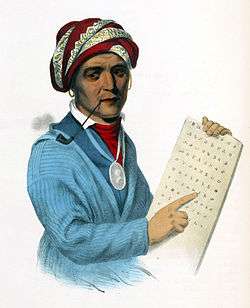 SE-QUO-YAH – a lithograph from History of the Indian Tribes of North America. This lithograph is from the portrait painted by Charles Bird King in 1828. | |
| Born | c. 1770 |
| Died | August 1843 (aged 72–73) San Fernando de Rosa, Coahuila, Mexico (near present day Zaragoza, Coahuila, Mexico) |
| Nationality | Cherokee, American |
| Other names | George Guess, George Gist |
| Occupation | Silversmith, blacksmith, educator, warrior, politician, inventor |
| Spouse(s) | 1st: Sally (maiden name unknown), 2nd: U-ti-yu, ᎤᏘᏳ |
| Children | Four with first wife, three with second |
| Parent(s) | Wut-teh and Nathanial Gist |
Early life
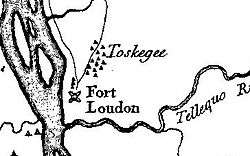

Sequoyah's heroic status has led to several competing accounts of his life that are speculative, contradictory, or fabricated.[5] As noted by John B. Davis, there were very few primary documents describing facts of Sequoyah's life. Some anecdotes were passed down orally, but these often conflict or are vague about times and places.[6]
Sequoyah was born in the Cherokee town of Tuskegee circa 1770. James Mooney, a prominent anthropologist and historian of the Cherokee people, quoted a cousin as saying that as a little boy, he spent his early years with his mother. Estimates of his birth year ranged from 1760 to 1776. His name is believed to come from the Cherokee word siqua meaning 'hog'. However, Davis says the name may have been derived from sikwa (either a hog or an opossum) and vi meaning a place or an enclosure.[6] This is a reference either to a childhood deformity or to a later injury that left Sequoyah disabled.[7]
His mother, Wut-teh, was known to be Cherokee. Mooney stated that she was the niece of a Cherokee chief. McKinney and Hall noted that she was a niece of chiefs who have been identified as the brothers Old Tassel and Doublehead. Since John Watts (also known as Young Tassel) was a nephew of the two chiefs, it is likely that Wut-teh and John Watts were cousins.
Sources differ as to the identity of Sequoyah's father. Davis cites Emmet Starr's book, Early History of the Cherokees, as the source for saying that Sequoyah's father was a peddler from Swabia named Guyst, Guist, or Gist.[6] According to Goodpasture, some believe the father was an unlicensed German peddler named George Gist, who came into the Cherokee Nation in 1768, where he married and fathered a child.[8] Grant Foreman identified him as Nathaniel Gist, son of a Christopher Gist, who later became a commissioned officer with the Continental Army associated with George Washington.[9] Mooney and others suggested that he was possibly a fur trader, who would have been a man of some social status and financial backing.[10] Josiah C. Nott claimed he was the "son of a Scotchman".[11] An article in the Cherokee Phoenix, published in 1828, stated that Sequoyah's father was a half-blood and his grandfather a white man.[6][12]
The New Georgia Encyclopedia presents another version of Sequoyah's origins, from the 1971 book, Tell Them They Lie: The Sequoyah Myth, by Traveller Bird, who claims to be a Sequoyah descendant. Bird says that Sequoyah was a full-blood Cherokee who always opposed the submission and assimilation of his people into the white man's culture. The encyclopedia noted that Bird presented no documentary evidence, but has gained some credibility in academic circles.[13]
In any case the father was absent before Sequoyah was born. Various explanations have been proposed, but the reason is unknown. Wuteh did not remarry afterward (assuming she married her son's father in the first place). There were no siblings, and Sequoyah was raised by his mother alone.[6] According to Davis, Sequoyah never went to school and never learned English. He and Wuteh spoke only Cherokee.[14] As a youth, he spent much of his time tending cattle and working in their garden, while his mother ran a trading post.[6]
Sequoyah became lame early in life, though how, when and where are not known. Some reports indicate this may have been caused by injury in battle; others say the cause was a hunting accident. Davis wrote that an early issue of the Cherokee Advocate said that "...he was the victim of a hydrarthritic trouble of the knee joint, commonly called 'white swelling'." One doctor speculated that he had anascara (sic).[6] In any case, lameness prevented him from being a successful farmer or warrior.
Despite his lack of schooling, Sequoyah displayed a good deal of natural intelligence. As a child, he had devised and built milk troughs and skimmers for the dairy house that he had constructed. As he grew older and came in contact with more white men, he learned how to make jewelry. He became a noted silversmith, creating various items from the silver coins that trappers and traders carried. He never signed his pieces, so there are none that can be positively identified as his work.[6]
Sequoyah may have taken over his mother's trading post after her death, which Davis claimed occurred about the end of the 18th Century. His store became an informal meeting place for Cherokee men to socialize and, especially, drink whiskey. Sequoyah developed a great fondness for alcohol and soon spent much of his time drunk. After a few months he was rarely seen sober, neglecting his farm and trading business and spending his money buying liquor by the keg.[6]
Fortunately, he realized that he was ruining his life, and took up new interests. He began to draw. Then he took up blacksmithing, so he could repair the iron farm implements that had recently been introduced to the area. Self-taught as usual, he made his own tools, forge and bellows. He was soon doing a good business either repairing items or selling items he had created himself. His spurs and bridle bits were in great demand because he liked to decorate them with silver. Although he maintained his store, he not only stopped drinking but stopped selling alcohol.[6]
Move to Alabama
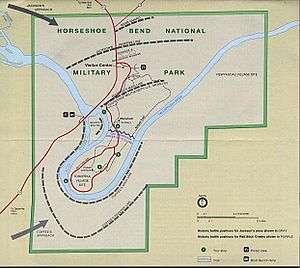
It is unclear when Sequoyah moved to Alabama from Tennessee. Some sources claim he went with his mother, though there is no confirmed date for her death. Others have stated that it was before 1809, when he started his work on the Cherokee Syllabary. Another source claims it was in 1818.[15] However, this date is too late, because he was already living in Alabama when he enlisted in the army. In 1813–14, Sequoyah served as a warrior of the Cherokee Regiment (Col. Gideon Morgan, Commander) at the Battle of Horseshoe Bend against the "Red Sticks" (Creek, or Muskogee, renegades).[16] His white comrades called him either George Guess or George Gist.[17]
The Encyclopedia of Alabama states that Sequoyah married Sally Benge in 1815.[16]
Sequoyah and Cherokee literacy
As a silversmith, Sequoyah dealt regularly with whites who had settled in the area. He was impressed by their writing, referring to their correspondence as "talking leaves". He knew that they represented a way to transmit information to other people in distant places. However, a majority of the Cherokees believed that writing was either sorcery, a special gift, or a pretense. Sequoyah accepted none of these explanations. He said that he could invent a way for Cherokees to talk on paper, even though his friends and family thought the idea was ridiculous.[6]
Creation of the syllabary
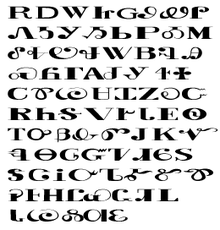
Around 1809, Sequoyah began creating a system of writing for the Cherokee language.[1] At first he sought to create a character for each word in the language. He spent a year on this effort, leaving his fields unplanted, so that his friends and neighbors thought he had lost his mind.[12][18] His wife is said to have burned his initial work, believing it to be witchcraft.[1] He realized that this approach was impractical because it would require too many pictures to be remembered. He tried making a symbol for every idea, but this also caused too many problems to be practical.[6]
Sequoyah decided to develop a symbol for each syllable in the language. After approximately a month, he had a system of 86 characters, some of which were Latin letters he obtained from a spelling book.[12] "In their present form, many of the syllabary characters resemble Roman, Cyrillic or Greek letters or Arabic numerals," says Janine Scancarelli, a scholar of Cherokee writing, "but there is no apparent relationship between their sounds in other languages and in Cherokee."[1]
Teaching the syllabary
Sequoyah first taught the syllabary to his six-year old[19] daughter, Ayokeh (also spelled Ayoka), because he could not find adults willing to learn it.[1] He traveled to the Indian Reserves in the Arkansaw Territory where some Cherokee had settled. When he tried to convince the local leaders of the syllabary's usefulness, they doubted him. Sequoyah asked each leader to say a word, which he wrote down, and then called his daughter in to read the words back. This demonstration convinced the leaders to let him teach the syllabary to a few more people. This took several months, during which it was rumored that he might be using the students for sorcery. After completing the lessons, Sequoyah wrote a dictated letter to each student, and read a dictated response. This test convinced the western Cherokee that he had created a practical writing system.[18]
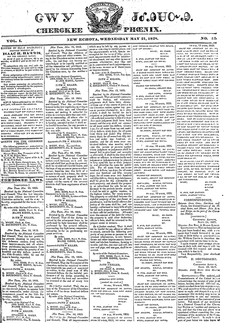
When Sequoyah returned east, he brought a sealed envelope containing a written speech from one of the Arkansas Cherokee leaders. By reading this speech, he convinced the eastern Cherokee also to learn the system, after which it spread rapidly.[12][18]
In 1824, the General Council of the Eastern Cherokees awarded Sequoyah a large silver medal in honor of the syllabary. According to Davis, one side of the medal bore his image surrounded by the inscription in English, "Presented to George Gist by the General Council of the Cherokee for his ingenuity in the invention of the Cherokee Alphabet." The reverse side showed two long-stemmed pipes and the same inscription written in Cherokee. Supposedly, Sequoyah wore the medal throughout the rest of his life and it was buried with him.[6]
Use of the syllabary in official documents and print
In 1825 the Cherokee Nation officially adopted the writing system. In 1826, the Cherokee National Council commissioned George Lowrey and David Brown to translate and print eight copies of the laws of the Cherokee Nation in the Cherokee language using Sequoyah's new system.[6] From 1828 to 1834, American missionaries assisted the Cherokee in using Sequoyah's syllabary to develop type characters and print the Cherokee Phoenix, the first newspaper of the Cherokee Nation, with text in both Cherokee and English.[4]
Impact of Sequoyah's syllabary beyond the Cherokee
The news that an illiterate Cherokee had created a syllabary spread throughout the USA. A missionary working in northern Alaska read about it and created a syllabary, what has become known as Cree syllabics. This syllabic writing inspired other groups across Canada to adapt the syllabics to their languages. A literate Cherokee emigrated to Liberia and told about their syllabary, leading a Bassa language speaker of Liberia to create his own syllabary, which led to other groups in West Africa to follow suit, creating their own syllabaries. A missionary in China read about the Cree syllabary and was inspired to follow that example in writing a local language in China. The result of all the diffusion of Sequoyah's work is that it has led to 21 scripts devised, used for over 65 languages.[20]
Life in Indian Territory
After the Nation accepted his syllabary in 1825, Sequoyah traveled to the Cherokee lands in the Arkansas Territory. There he set up a blacksmith shop and a salt works. He continued to teach the syllabary to anyone who wished.
In 1828, Sequoyah journeyed to Washington, D.C., as part of a delegation to negotiate a treaty for land in the planned Indian Territory. While in Washington, D.C., he sat for a formal portrait painted by Charles Bird King (see image at the top of this article). He holds a copy of the syllabary in his left hand and is smoking a long-stemmed pipe. During his trip, he met representatives of other Native American tribes. Inspired by these meetings, he decided to create a syllabary for universal use among Native American tribes. Sequoyah began to journey into areas of present-day Arizona and New Mexico, to meet with tribes there.
In 1829, Sequoyah moved to a location on Big Skin Bayou, near the present city of Sallisaw, Oklahoma, where he built Sequoyah's Cabin that became his home for the rest of his life. It was declared a National Historic Landmark in 1965.[21] It was operated by the Oklahoma Historical Society until it was purchased by the Cherokee Nation 9 November 2016.[22]
In 1839, when the Cherokees were bitterly divided over the issue of removal to Indian Territory, Sequoyah joined with Jesse Bushyhead to try to reunite the Cherokee Nation. Sequoyah, representing the Western Cherokees, and Bushyhead representing the Eastern Cherokees, made a joint plea at a tribal council meeting at Takatoka on 20 June 1839, where they succeeded in getting a voice vote to hold a new council of all Cherokees to resolve the reunification issues.[23]
Sequoyah's last journey and death
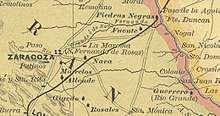
Sequoyah dreamed of seeing the splintered Cherokee Nation reunited. In the spring of 1842, Sequoyah began a trip to locate other Cherokee bands who were believed to have fled to Mexico and attempted to persuade them to return to the Cherokee Nation. He was accompanied by his son, Teesy (Chusaleta), as well as other Cherokees identified as Co-tes-ka, Nu-wo-ta-na, Cah-ta-ta, Co-wo-si-ti, John Elijah, and The Worm:[6]
"In the summer of 1842, influenced perhaps by a desire to explore the Western prairies, and become acquainted with his Red Brethren, who roam them free and untrammlled, Se-quo-yah, having loaded several pack horses with goods, visited, in company with a number of Cherokees, the Cumanche Indians. After remaining with them some time, he made his way with a son and two or three other Cherokees, into Northern Mexico, toward Chi-hua-hua, and engaged a while in teaching the Mexicans his native language."
— Mississippi Democrat, Carrollton, Mississippi, Wednesday Morning, January 22, 1845[24]
Sometime between 1843 and 1845, he died during a trip to San Fernando de Rosas in Coahuila, Mexico; a letter written in 1845 stated that he died in August 1843:[6]
Warren's Trading House, Red River,
April 21st, 1845.
We, the undersigned Cherokees, direct from the Spanish Dominions, do hereby certify that George Guess of the Cherokee Nation, Arkansas, departed this life in the town of San-fernando in the month of August, 1843, and his son Chusaleta is at this time on the Brasos River, Texas, about thirty miles above the falls, and he intends returning home this fall. Given under our hands the day and date written.
STANDING X ROCK (his mark)
STANDING X BOWLES (his mark)
WATCH X JUSTICE (his mark)
WITNESSES
Daniel G. Watson
Jesse Chisholm
The village of San Fernando de Rosas was later renamed to Zaragoza.
In 1938, the Cherokee Nation Principal Chief J. B. Milam funded an expedition to find Sequoyah's grave in Mexico.[25] A party of Cherokee and non-Cherokee scholars embarked from Eagle Pass, Texas, on January 1939. They found a grave site near a fresh water spring in Coahuila, Mexico, but could not conclusively determine the grave site was that of Sequoyah.[26]
In 2011, the Muskogee Phoenix published an article relating a discovery in 1903 of a gravesite in the Wichita Mountains by Hayes and Fancher which they believed was Sequoyah's. The two men said the site was in a cave and contained a human skeleton with one leg shorter than the other, a long-stemmed pipe, two silver medals, a flintlock rifle and an ax. However, the site was far north of the Mexican border.[27]
Legacy
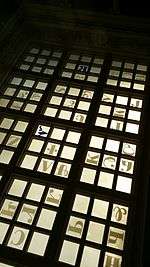
- Oklahoma gave a statue of Sequoyah to the National Statuary Hall Collection in 1917. This was the first statue representing a Native American to be placed in the hall. It was created by Vinnie Ream, and is displayed in the Capitol rotunda in Washington D. C.[28]
- A monument honoring Chief Sequoyah of the Cherokee Indian Nation was dedicated in September 1932 at Calhoun, Georgia.[29] 34.530286°N 84.936806°W
- 1939, a bronze panel with a raised figure of Sequoyah, by Lee Lawrie, was erected in his honor at the Library of Congress.
- Sequoyah's Cabin, where he lived during 1829–1844 in Oklahoma, was designated a National Historic Landmark in 1965.
- On 20 December 1980 the United States Postal Service issued a 19¢ stamp in his honor in the Great Americans series.[30]
- Addressing the exalted place Sequoyah holds in Cherokee imagination, the ethnographer Jack Kilpatrick wrote: "Sequoyah was always in the wilderness. He walked about, but he was not a hunter. I wonder what he was looking for."[26]
- The Sequoyah Birthplace Museum in Eastern Tennessee features his life and Cherokee culture.[31]
- Johnny Cash sang about Sequoyah in his 1964 song "The Talking Leaves"
- Sequoyah is pictured on the reverse of the 2017 Sacagawea Dollar coin.
- In 1964, he was inducted into the Hall of Great Westerners of the National Cowboy & Western Heritage Museum.[32]
- A painting of Sequoyah by artist Henry Inman from ca. 1830 hangs in the United States National Portrait Gallery.[33]
 Statue of Sequoyah in United States Capitol
Statue of Sequoyah in United States Capitol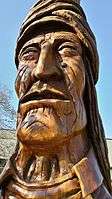 Sequoyah Memorial in front of the Cherokee Museum in North Carolina
Sequoyah Memorial in front of the Cherokee Museum in North Carolina Bronze panel featuring Sequoyah (1939), by Lee Lawrie. Library of Congress John Adams Building, Washington, D.C.
Bronze panel featuring Sequoyah (1939), by Lee Lawrie. Library of Congress John Adams Building, Washington, D.C.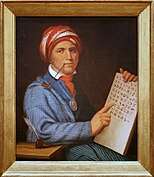 Portrait of Sequoyah by Henry Inman, ca. 1830. In the National Portrait Gallery.
Portrait of Sequoyah by Henry Inman, ca. 1830. In the National Portrait Gallery.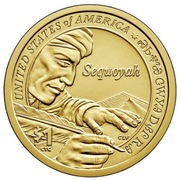 The reverse of the 2017 Sacagawea dollar depicts and honors Sequoyah
The reverse of the 2017 Sacagawea dollar depicts and honors Sequoyah
Namesake honors
- The Sequoia trees in California were named Sequoia gigantea in 1847 by Austrian biologist Stephan Endlicher. While it has generally been assumed that this was in honor of Sequoyah, this hypothesis has been questioned.[34] However, recent research in Austria has established that Endlicher, also a published linguist, was familiar with Sequoyah's work.[35]
- A crystalline chemical compound found by distilling the needles of the trees was described by Georg Lunge and Th. Steinkaukler in 1880 and named sequoiene.[36]
- The caterpillar of the sequoia-borer moth, a sesiid moth, was named Bembecia sequoiae.[6][37]
- The name of the district where Sequoyah lived in present-day Oklahoma was changed to the Sequoyah District in 1851. When Oklahoma was admitted to the union, that area became known as Sequoyah County.[6]
- The proposed State of Sequoyah was named in his honor.[6]
- Sequoyah Research Center is dedicated to collecting and archiving Native American writing and literature.
- Mount Sequoyah in the Great Smoky Mountains.
- Mount Sequoyah in Fayetteville, Arkansas was named in honor of him after the city donated the top of East Mountain to the Methodist Assembly for a retreat.
- The Sequoyah Hills neighborhood of Knoxville, Tennessee.
- The Tennessee Valley Authority Sequoyah Nuclear Plant bears his name.
- The Sequoyah Marina on Norris Lake in Tennessee, upstream from Norris Dam on the Clinch River.
- The USS Sequoia was a long-time yacht used by American Presidents (now privately owned).
- Sequoyah Caverns and Ellis Homestead is in Valley Head, Alabama.[38]
- Sequoyah Country Club, Oakland California[39]
- Sequoyah Council – A Boy Scouts of America Council located in Northeast Tennessee.
- The Sequoyah Book Award is chosen annually by students in Oklahoma.
- Many schools have been named for him, including
- College of the Sequoias (Visalia, California)
- Sequoyah High School (Georgia), Canton (Cherokee County), Georgia
- Sequoyah High School (Oklahoma), a Native American boarding school in Tahlequah, Oklahoma
- Sequoyah High School (Tennessee), Madisonville, Tennessee
- Sequoia High School (Redwood City, California)
- Sequoya Elementary School, Tahlequah, Oklahoma
- Sequoyah Elementary School, Shawnee, Oklahoma
- Sequoia Junior High School, Simi Valley, California
- Sequoyah Elementary School, Tulsa, Oklahoma
- Sequoia Elementary School, San Diego, California
- Sequoya Elementary School, Russellville, Arkansas
- Sequoya Middle School, Broken Arrow, Oklahoma
- Sequoya Elementary School, Derwood, Maryland
- Sequoyah School, Pasadena, California
See also
- The development of writing
- Bob Benge, Cherokee leader
- Old Tassel
- List of people who disappeared
- Hastings Shade (1941–2010), fifth-generation direct descendant of Sequoyah
- Tahlonteeskee (Cherokee chief)
References
- Wilford, John Noble (22 June 2009). "Carvings From Cherokee Script's Dawn". New York Times. Retrieved 23 June 2009.
- Morand, Ann; Kevin Smith; Daniel C. Swan; Sarah Erwin (2003). Treasures of Gilcrease: Selections from the Permanent Collection. Tulsa, OK: Gilcrease Museum. ISBN 0-9725657-1-X.
- Holmes, Ruth Bradley; Betty Sharp Smith (1976). Beginning Cherokee: Talisgo Galiquogi Dideliquasdodi Tsalagi Digoweli. Norman: University of Oklahoma Press. ISBN 0-8061-1362-6.
- "Sequoyah". New Georgia Encyclopedia. Retrieved 3 January 2009.
- Fogelson, Raymond D. (1974). "On the Varieties of Indian History: Sequoyah and Traveller Bird". Journal of Ethnic Studies. 2.
- Davis, John B. (1930). The Life and Work of Sequoyah. Chronicles of Oklahoma. 8. Archived from the original on 28 October 2017. Retrieved 20 November 2017.
- London, 193
- Goodpasture, Albert V. (October 1921). The Paternity of Sequoya the Inventor of the Cherokee Alphabet. Chronicles of Oklahoma. 1. Retrieved 4 April 2013. Italic or bold markup not allowed in:
|work=(help) - Samuel C. Williams (March 1937). "The Father of Sequoyah: Nathaniel Gist". Volume 15, No. 1. Chronicles of Oklahoma. pp. 10–11. Retrieved 27 September 2010.
- Robert Bieder, "Sault-ste-marie-and-the-war-of-1812", Indiana Magazine of History, XCV (Mar 1999), accessed 13 December 2008
-
Nott, Josiah C. (1849). "Two lectures on the connection between the Biblical and physical history of mankind". New York: Bartlett and Welford: 35. Cite journal requires
|journal=(help) - G. C. (13 August 1820). "Invention of the Cherokee Alphabet". Cherokee Phoenix. 1 (24).
- Wadley, Ted (2002). "Sequoyah". New Georgia Encyclopedia. Retrieved 6 April 2013.
- Langguth, p. 71
- "Wills Town Mission and Cemetery, Alabama". exploresouthernhistory.com. Retrieved 9 April 2013.
- Abram, Susan M. "Sequoyah". Encyclopedia of Alabama History. Retrieved 7 April 2013.
- Langguth, p. 68.
- Boudinot, Elias (1 April 1832). "Invention of a New Alphabet". American Annals of Education.
- Langguth, p. 70
- Unseth, Peter (2016). "The international impact of Sequoyah’s Cherokee syllabary". Written Language and Literacy 19.1: 75–93.
- Joseph Scott Mendinghall (9 December 1975). "National Register of Historic Places Inventory-Nomination: Sequoyah's Cabin" (pdf). National Park Service. Cite journal requires
|journal=(help) and Accompanying 4 photos from 1975. (1.11 MB) - Indian Country Today November 2016
- McLoughlin, p. 14
- "Se-quo-yah, or George Guess". Mississippi Democrat. 22 January 1845.
- J. B. Milam, McFarlin Library, University of Tulsa. Archived 11 January 2006 at the Wayback Machine Libraries & Cultures: Bookplate Archive. 2001 (retrieved 23 June 2009)
- Meredith, Howard L. (1985).Bartley Milam: Principal Chief of the Cherokee Nation. Muskogee, OK: Indian University Press, p. 47. ISBN 0-940392-17-8
- Mullins, Jonita (13 November 2011). "Sequoyah's gravesite remains unknown". Muskogee Phoenix. Retrieved 6 April 2013.
- "Explore Capitol Hill". Architect of the Capitol. Retrieved 4 April 2013.
- "Monument honoring Chief Sequoyah of the Cherokee Indian Nation. Calhoun, Georgia. September 1932". Atlanta Journal-Constitution Photographic Archive. Georgia State University Library. Retrieved 4 November 2016.
- GeorgiaInfo "Sequoyah Stamp." Retrieved 4 April 2013.
- "Sequoyah Museum: The Sequoyah Birthplace Museum".
- "Hall of Great Westerners". National Cowboy & Western Heritage Museum. Retrieved 22 November 2019.
- "Sequoyah". npg.si.edu. Retrieved 11 March 2020.
- Lowe, Gary D. 2012. Endlicher's sequence: the naming of the genus Sequoia. Fremontia 40, nos. 1 & 2: 25–35.
- Muleady-Mecham, Nancy. "Endlicher and Sequoia: Determination of the Entymological Origin of the Taxon Sequoia". Bulletin of the Southern California Academy of Sciences. Occidental College. Retrieved 7 March 2018.
- Gesellschaft, Deutsche chemische (1 July 1880). "Berichte der Deutschen chemischen Gesellschaft zu Berlin".
- Scheidt, Laurel. Hiking Sequoia and Kings Canyon National Parks. Guilford, CT: Globe Pequot Press, 2002: 68. ISBN 978-0-7627-1122-2 (retrieved through Google books, 23 June 2009)
- "Sequoyah Caverns and Ellis Homestead".
- "Welcome to Sequoyah Country Club". Retrieved 2 September 2010.
Bibliography
- Bender, Margaret. (2002) Signs of Cherokee Culture: Sequoyah's Syllabary in Eastern Cherokee Life. Chapel Hill: University of North Carolina Press.
- Feeling, Durbin. Cherokee-English Dictionary: Tsalagi-Yonega Didehlogwasdohdi. Tahlequah, Oklahoma: Cherokee Nation, 1975: xvii
- Holmes, Ruth Bradley; Betty Sharp Smith (1976). Beginning Cherokee: Talisgo Galiquogi Dideliquasdodi Tsalagi Digoweli. Norman: University of Oklahoma Press. ISBN 0-8061-1362-6.
- Foreman, Grant, Sequoyah, University of Oklahoma Press, Norman,OK, 1938.
- Langguth, A. J. Driven West: Andrew Jackson and the Trail of Tears to the Civil War. New York, Simon & Schuster. 2010. ISBN 978-1-4165-4859-1.
- McKinney, Thomas and Hall, James, History of the Indian Tribes of North America. (Philadelphia,PA, 1837–1844).
- McLoughlin, William G., After the Trail of Tears: The Cherokees' Struggle for Sovereignty 1839 – 1880. University of North Carolina Press. Chapel Hill. 1993. ISBN 0-8078-2111-X.
External links
| Wikimedia Commons has media related to Sequoyah. |
| Wikisource has the text of the 1920 Encyclopedia Americana article Sequoyah. |
- "Invention of the Cherokee Alphabet", Cherokee Phoenix, 13 August 1828
- John B. Davis, "The Life and Work of Sequoyah", Chronicles of Oklahoma, Vol.8 (2), June 1930, Oklahoma State University
- "Sequoyah", Tiro Typeworks
- "Sequoyah (aka George Gist)", a North Georgia Notable
- The Cherokee Nation Official Website
- "The Official Cherokee Font" at the Cherokee Nation Official Website
- Sequoyah at Find a Grave
